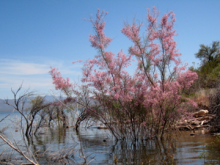Article
A tall, water-loving shrub indigenous to Asia and the Mediterranean, tamarisk, also known colloquially as salt cedar, was introduced to U.S. Southwest waterways to assist in stabilization and erosion control at the turn of the twentieth century. As a non-native species with no biological controls naturally present to inhibit its proliferation, tamarisk quickly became an invasive species, overtaking waterways, choking out native plant species and consuming the water it was supposed to help conserve. Because tamarisk is now considered an ecological threat to the already fragile hydrological systems of the southwestern deserts of the U.S., municipal, state, regional, and federal task forces invest time and money on teams of "tammywhackers," who work to manually remove tamarisk from the riverbanks to which they were introduced in the late 19th century.
"Not so pretty in pink, tamarisk is a major nuisance, April 11, 2010" by Alan Levine is licensed under CC BY.
Manuscripts
References
Encyclopædia Britannica Online
N.d. Tamarisk. http://www.britannica.com/EBchecked/topic/581811/tamarisk, accessed
February 03, 2015.
Invaders, Citizen Scientists Combat Invasive Species
N.d.v Tamarisk, saltcedar, athel tree (Tamarix spp.)
http://www.desertmuseum.org/invaders/invaders_tamarisk.php
Stevens, Larry E.
N.d. Exotic Tamarisk on the Colorado Plateau.
http://cpluhna.nau.edu/Biota/tamarisk.htm, accessed February 3, 2015.

